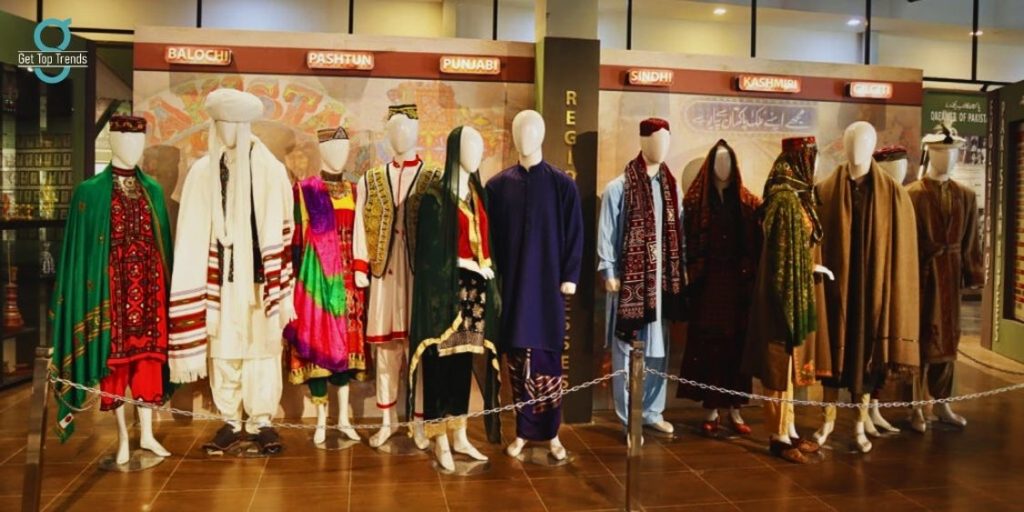Pakistan, with its rich cultural tapestry, boasts a diverse array of traditional dresses that reflect the vibrancy and heritage of its people. From the intricate embroidery to the vibrant colours, each region showcases its unique identity through clothing. Let’s explore Pakistani traditional dresses and fill your wardrobe with new style!
A Journey To Your Traditional Wardrobe
In this blog, we will explore five beautiful Pakistani traditional dresses, including Afghani, Punjabi, Kashmiri, Gilgiti, and Sindhi attire, for both men and women.
1. Afghani Attire
Afghani clothing for Women is Chador and Paranja. Afghan women often wear a Chador, a loose, full-length cloak, paired with a Paranja, a face veil. These garments not only reflect modesty but also showcase exquisite hand embroidery and vibrant colours.
In Afghani tradition, Pakol and Perahan Tunban are famous for men. The traditional Afghan men’s attire includes the distinctive Pakol, a round-topped hat, and Perahan Turban, a long shirt paired with loose-fitting trousers. The combination exudes a classic and timeless charm.
2. Punjabi Dresses
A famous Punjabi dress for women is the Patiala Suit. The Patiala Suit is a popular choice for Punjabi women. The outfit comprises a flowing kameez (long tunic) paired with a Patiala salwar (pleated baggy pants) and a matching dupatta. The vibrant colours and intricate embroidery make it a festive favourite.
However, for Men, Kurta Pajamas and Turban are mostly used. Men in Punjab often don the Kurta Pajama, a long tunic paired with straight-cut trousers. The ensemble is completed with a colourful turban, showcasing the cultural pride and regality of the region.

3. Kashmiri Ensemble
Pheran is a traditional Kashmiri dress for women. The traditional Kashmiri Pheran is a loose, long tunic, often adorned with intricate Kashmiri embroidery called ‘Aari work.’ Paired with a Pashmina shawl, it creates an elegant and graceful look.
On the other side, Kashmiri Pheran and Shalwar are popular among Kashmiri men. Men wear a similar version of the Pheran, paired with straight-cut shalwar (trousers). The earthy tones and delicate craftsmanship capture the essence of Kashmiri culture.
4. Gilgit Garb
Gilgit-Baltistan showcases a unique style with women wearing vibrant-coloured dresses adorned with the Gilgiti Topi, a traditional cap, and a matching dupatta. The overall look is both distinctive and elegant.
Men in Gilgit-Baltistan opt for a classic Shalwar Kameez paired with an intricately embroidered waistcoat. The combination reflects the rich cultural heritage of the region. So, if you want to buy traditional clothes for men & women, visit Saqafat Khana, a renowned Pakistani traditional clothing store.
5. Sindhi Splendor
The Sindhi Ajrak, a block-printed shawl, is a prominent feature in women’s traditional attire. Paired with a vibrant Lehenga Choli, the ensemble showcases a riot of colours and intricate detailing.
Men adorn themselves with the Sindhi Topi, a traditional cap, and a matching Ajrak scarf. This combination adds a touch of cultural pride and sophistication to the attire.
Conclusion
Pakistani traditional dresses not only mirror the diversity of the country but also celebrate the rich cultural heritage passed down through generations. Whether it’s the vibrant colours of Punjab, the regal elegance of Kashmir, or the unique styles of Gilgit and Sindhi, each traditional dress tells a story of history, tradition, and identity. Get Top Trends always brings something meaningful for you. These garments tips by Get Top Trends are not just a fashion statement but a tribute to the timeless beauty of Pakistani culture.


